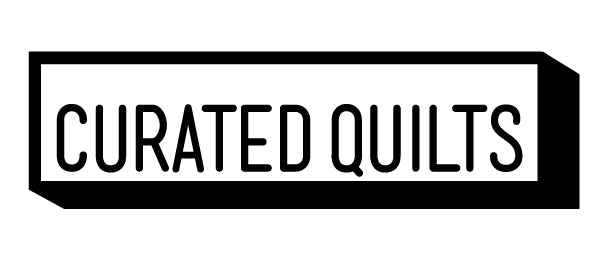In art, positive space is the area of interest in an artwork. Conversely, negative space is the background area that surrounds the subject.
In our current call for submissions, we are asking for quilts that incorporate the use of negative space as the primary design element of the quilt. Negative space is a well-established art concept and a quick Google search will yield numerous examples and philosophies of how to use it to great effect.
Here we’ve compiled some of our thoughts about negative space; how it can successfully make quilt design better, and some examples of how quilters expertly used it in their quilts.
Negative space is a place for special quilting or for the quilting itself to create a major impact of the overall design of the quilt:
Red Blue by Carson Converse @carsonconverse
The machine stitching on this quilt takes Converse’s muted palette and elevates it. The color of thread used and spacing of the sewn rows creates its own pattern within the negative space of the quilt.
Falling Folds by Claire Victor @cvquilts
Victor expertly mirrors her pieced quilt pattern with stunning machine quilting. This creates meaningful movement in the areas of negative space as well as creating a sort of symmetry with the continuation of the pieced pattern.
Thoughtful use of negative space gives the eye a place to rest:
Zester by Caroline Hadley @geometriquilt
Not only has Hadley interestingly played with the removal of a portion of a circle shape and filled it with flying geese, but a wide half-framing of the quilt grounds it.
Drag Race by Andrea Salisbury @andreasalisbury
The large swaths of negative space in this quilt help balance the busyness of the lone star motif. It also helps to draw attention to busyness as well.
Negative space quilts may seem to play tricks with your eyesight. This is most often accomplished by manipulating size and shape:
That Which We Call A… by Danielle Ketcham @magicquilting1
When walking past this quilt in person, it was easy to miss the overall effect that can be seen when looking at the quilt from afar. Minute adjustments to space can have a big impact to a quilt as a whole.
Take the Stairs by Charles Cameron @feltlikesweets
The space Cameron has created with variously sized squares makes this quilt vibrate. This quilt is a great example of how negative space doesn’t simply mean empty space or vast amounts of space, but it does mean creating thoughtful space that adds to the overall quilt design.
Negative space can be created through the process of subtraction, or removing a piece of your design to create space:
Metropolis by Laura Glass @laura.glasses
Glass has carefully removed portions of original quilt pattern and replaced the space created with color. This use of color creates a secondary design that works harmoniously with the first. Her quilt is also filled with structured movement.
We can’t wait to see how you interpret the use of negative space in our call for Negative Space quilts. Submissions are due by June 20, 2022.
